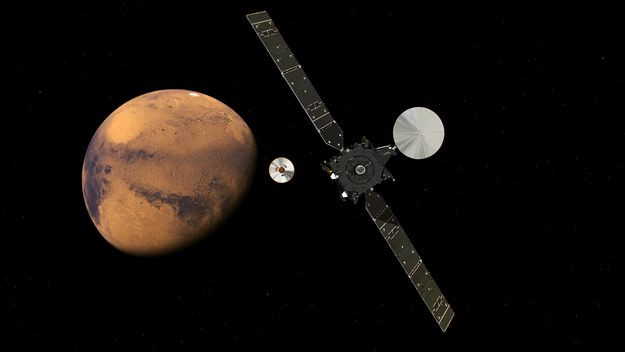ExoMars Mission: ESA Confirms TGO Orbit Insertion Successful, Fate Of Lander Still An ‘Open Question’

The ExoMars mission is a “huge success,” European Space Agency (ESA) officials announced during a press conference Thursday. However, the fate of the Schiaparelli Entry, Descent and Landing demonstrator module (EDM), which was supposed to make a soft landing on the surface of the red planet at 10:42 a.m. EDT Wednesday, is still unknown.
“We don’t know,” ESA officials said, when asked about the likelihood that the lander was in one piece, adding that in the last few seconds before the Schiaparelli’s landing, it had “not behaved as we expected.”
“We need to understand what happened in the last few seconds before the landing, and that will take some time,” the space agency officials said during the press conference.
However, despite the hitch in landing the EDM module, ESA was quick to emphasize that the mission was a massive success, as all the main goals — placing the ExoMars Trace Gas Orbiter (TGO) in orbit around Mars to serve as a relay module for the second phase of the ExoMars mission scheduled to take place in 2020, and gathering "meaningful" data during Schiaparelli's six-minute descent — had been accomplished.
"Following yesterday’s events we have an impressive orbiter around Mars ready for science and for relay support for the ExoMars rover mission in 2020,” Jan Wörner, ESA’s director general, said in a statement. “Schiaparelli’s primary role was to test European landing technologies. Recording the data during the descent was part of that, and it is important we can learn what happened, in order to prepare for the future."
The fate of the lander is likely to be revealed in the coming days when further data is gathered by ESA’s Mars Express and NASA’s Mars Reconnaissance Orbiter.
“If Schiaparelli reached the surface safely, its batteries should be able to support operations for three to ten days, offering multiple opportunities to re-establish a communication link,” ESA explained in an earlier statement. “TGO is equipped with a suite of science instruments in order to study the Martian environment from orbit. Although mostly a technology demonstrator, Schiaparelli is also carrying a small science payload to perform some observations from ground.”
The main objective of the ExoMars mission is to search for evidence of methane — a gas emitted by living microbes on Earth, and traces of which have been observed by previous Mars missions — and other trace atmospheric gases that could be signatures of active biological or geological processes.
The next phase of the joint Roscosmos-ESA mission aims to land a rover on Mars. So far, only four rovers — Sojourner, Spirit, Opportunity and Curiosity, all sent by NASA — have successfully landed on Mars.
"Mars exploration is hard, but that's why we do it," David Parker, director of ESA's human spaceflight and robotic exploration division, said during the press conference.
© Copyright IBTimes 2025. All rights reserved.






















